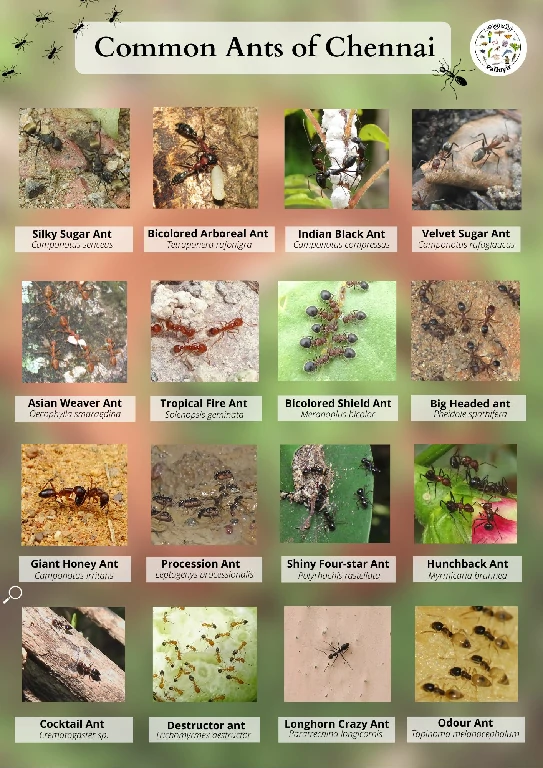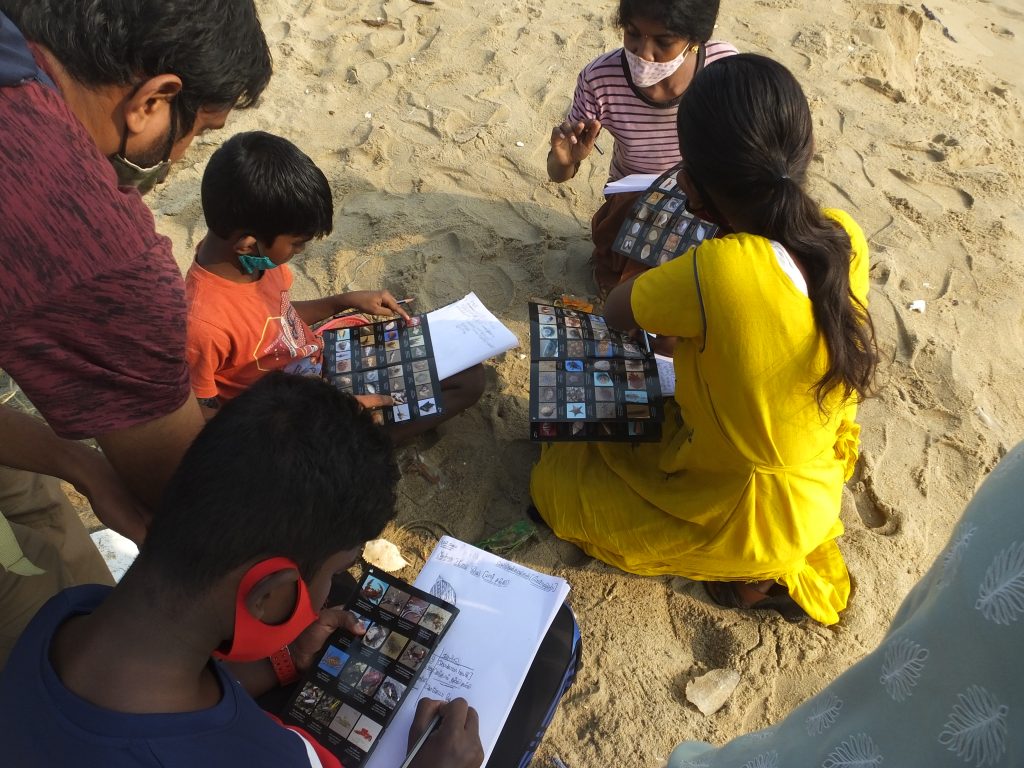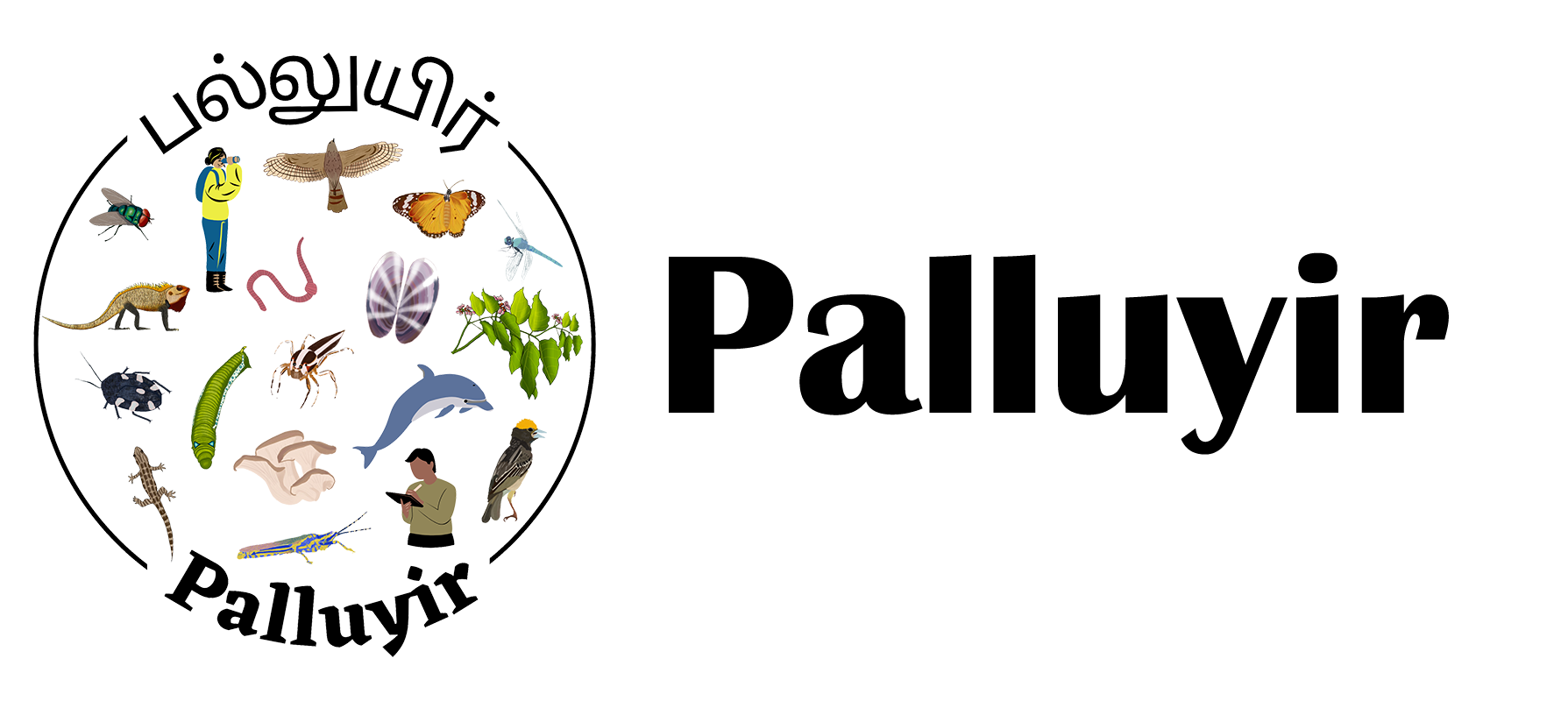On the role of local nature on children’s language acquisition and the role of language in protecting our living world
by Yuvan Aves
Hunchback ants are attending to clumpy masses of mealybugs on a lady’s finger plant outside the classroom. These ants are called Koon Erumbu in Tamil, a name my team and I kept for the, like its English name, referring to its hunched gaster. We are conducting an ant observation activity at Nungambakkam girls’ school in Chennai. We find the Neruppu Erumbu (Fire Ant) and Katta Erumbu (Indian Black Ant) foraging from two ends of a dropped dosa under a rain tree. Kids held magnifying glasses over them and noticed the different sizes of workers in both ant species, while some others were more intent on using the implement to focus sunlight and scorch the pages of their journals. For observing ants they used the single-page field guide we had made for them with sixteen species of Chennai’s common ants. And another sheet with various behaviors ants exhibit – antennating, living raft, ant-tournaments, myrmecophily, foraging trails, nest-building, and many others. The children observed different portions of their school grounds through this completely new portal to them. They drew the ants’ head, mesosoma and gaster and journalled the features they saw on each species. Most journalled about 7 – 8 species. They were finding fresh wonder in a place that they come to daily and seemed like it hosted no life.
While discussing the ant sessions we did in five of Chennai’s corporation schools amongst us nature-educators reviewing the fortnight, we noticed that much of what we do involves teaching children names, new names – of ants, trees, wildflowers, dragonflies, butterflies, and other co-habitants of our city. Also, names of features, processes, and relationships in our immediate living world. Through these names, we teach practices of observing deeply – other beings and oneself. And naming somehow is somewhere at the center of this. A large part of being a nature-educator is being a name-teacher. Perhaps that is true of any educator.

A field guide for the common ant species found in Chennai
Lisa Feldmann Barrett comes to mind when pondering this, a renowned neuroscientist from Northeastern University. She says that the more specificity we can use to ‘name’ our emotions (which is the language of the ecosystem within us), the better mental health we can have. She calls this emotional granularity. To create this granularity for people is among the main occupations of mental health professionals. They are name-teachers of a certain kind too. I am raptured by this resonance between land and mind and the similarity of work between mind-teachers and land-teachers. ‘Naming’ of a certain kind shapes, vividifies, dignifies, and makes healthy our mind and land and our relationship with it. To have good language widens our perception inwardly and outwardly. Any language itself is a unique framework to stitch names/nouns together, to draw relationships between acknowledged specific things and beings. All other parts of speech exist only in relationality to names.
A name is an intriguing thing in the mind – it is an outline, a thumbtack, a designated space within to symbolize something. A dedicated place for something to exist in the mind. It is an element in order to imagine, think, speak, even notice. It can be a way to give identity, separate, visibilize or invisibilize, and create even – as we make new names and words. It segments spectrums of existence. It is the point of recall and remembering, and even invoking, acknowledging, restoring, protecting, or erasing. But most importantly, a name is a way to share our individual realities with each other while speaking in terms of things in common. To name something perhaps for the mind is also magic most often – to summon something non-existent into our perceptual existence. Just like in the Earthsea novels written by Ursula Le Guin, the strongest magic was to call something or someone by their real name.
Other social and vocal animals other than humans have and use names too. Dolphins are named by their mothers – with unique signature clicks – which peers later use to call individuals. In species of parrots, moms and dads give their chicks unique peeps and clicks, which become their names in their community. Sounds trigger pictures, memories, and expectations/predictions in mind in them too. Neuroscientist Erich Jarvis notes that other primates which are less vocal than humans, have a ‘gestural language’ which is far more comprehensive than ours.
One early monsoon day several years ago, I was at Goonangkuppam village, which is at the furthest tip of Kattupalli barrier island sheltering the Pulicat lagoon North of Chennai. I stood by three heaps of bivalve and gastropod shells at a boat dockyard, documenting the species collected there as well as trying to document their vernacular names. This was part of what is now a long-term project by the Madras Naturalists’ Society to document coastal biodiversity, local knowledge, and stories about and threats to coastal habitats in Tamil Nadu. The shell heaps in Googangkuppam were being sun-dried before being sold to a lime kiln. I asked nearby fishermen in their twenties and thirties playing cards in the shade of their boats for the local names of different shells I held up. They were forthcoming, but their lexicon for all gastropods was a generic ‘sangu’ (conch) and sometimes descriptively so, like periya sangu (big conch) and neeta sangu (long conch). Similarly, the specimens on the bivalve heap were largely given generic names like Kinzhinjal (used for any shell or shell shard) and Aazhi (Oysters). Till Muthu anna, a 60 + year old elder fisher, and his wife came around interested in what I was asking people. The shells, through his speech acquired intense vividness, each with its own specific name – Grey Bonnet was Paal Kuda (Milk vessel), Ribbed Cockle was Kili Mooku (Parakeet’s beak), Babylon snail was Pura Muttai (Pigeon egg) and like this he told names and often stories for each. Many of these names were the same among the fisher elders of other coastal districts in Tamil Nadu too, while several species had numerous names. Elders knew more stories as well. The Pathira sangu (Vessel shell), also known as Pandara sangu (Beggar’s shell) were common names for the massive Bailer shell (Melo melo). I was told in many villages that it was used back in the day as a measure for salt, sugar, flour, etc, before the advent of plastic, while it was also used to collect alms. The Nasarius and Cowries are called Kaasu Oori and Kaasu Sozhi – Kaasu meaning coin-money – as they were once used as currency on these coasts. This overlaps interestingly with research on how and why we learn names. Specific names, as opposed to generic names, are processed by the same circuits in our brain as social cognition. Or in other words, specific names are learnt and remembered or fading and forgotten in changing social dynamics.
Among younger and middle-aged fishers, there was a general pattern in which they knew specific names. Either something was caught and eaten, had some economic value, or something was harmful and dangerous – then it was sure to have specific names. There are also numerous beings that we just co-exist with, which we don’t interact with extractively or in a hostile manner. Of these, the striking and beautiful are more likely to have specific names. Others can often be invisible to our perception. I somewhat believe – and I think this pattern of learning and speaking specific names is true in different human communities – that the volume of names we have for simply coexistent species and entities is a great indicator of a community’s felt and socialized connection with their local ecology and each other. It indicates the extent to which a person or community’s selfhood is entangled with their inhabited place. This applies to knowing people’s names too in our local community, beyond whom our interactions are only transactive and useful – is quite indicative of the depth of our relationality within it.
Our coastal documentation work resulted in a field guide to Coastal Fauna in Chennai and surrounding districts with 160 species in it, along with many posters and resource materials that we created to engage children from the fisher communities in activities on their home-beach, making it a rich living learning space. While also trying to bring back these vanishing words into their daily speech. And for the names already forgotten, we made new ones.
The coastal curriculum we ran emplaced in the coastal biodiversity and various phenomena present here also was integrated with children’s learning outcomes in school. The first and most prominent change we saw in children was improvement in language – writing, speaking, and reading. Connection with nature gave them a drive and purpose to learn language in order to know their home-coast more intimately. Psychologist Adam Grant says that the only thing which creates intrinsic motivation – that is, motivation which is driven by the individual’s own desire to learn more – is curiosity. And in the coastal apprenticeship it was getting clearer to me – as I had been discovering over the past 12 years as a nature-educator. That few other experiences more than local nature engagement could create epistemic curiosity (desire for new knowledge) and sensorial curiosity (desire for new sensorial experiences) in learners of all ages.
Language first emerged in humans from natural sounds and through its mimicry. And in all species that have advanced vocal language – including whales, humans, dolphins, parakeets, mynahs, and others, language develops for each individual very similarly to how it emerged evolutionarily for all of life. First, the mimicry of natural sounds and those physiologically easier to make, evolve. A toddler is more comfortable calling a dog bowbow or a cat as meow which tangibly evokes the creature, rather than ‘dog’ or ‘cat’, which are abstract words. This stage is soon surpassed to understand names as vocal symbols and mental concepts commonly agreed upon. Not mimicking sounds associated with each species, object or process vastly widens the scope of what can be spoken. And these symbolized vocal sounds are further represented by visual symbols in a range of ways which are script.
I work with children all across the age and socioeconomic spectrum. It always seems the case that language skills – reading and writing (not necessarily speaking) develop slowly and with struggle in working-class children, while in privileged children with a certain home environment, parental care, and access to resources, these skills develop fast and give the child much greater social mobility (which is not necessarily social flexibility). And here – like in the coastal curriculum example – I have seen engagement with nature hold tremendous equalizing scope, especially in developing language skills – whose social relevance cannot be overemphasized. Noam Chomsky, in his famous essay on language, says that all humans are born with the potential to learn language, and what inhibits it is a poverty of stimulus. The famous Hart-Risley study delved deeper into this poverty of stimulus and found that children in their language-sensitive period (a time when the window of learning language is open) who were spoken to by their caregivers more than 20 million words by the time they were 5 years old, are well socialized later, while those children who are spoken to less than 8 million words via stories, conversations, cuddling speech, reading to or any interaction – typically struggle later in life socially and cognitively. Philosopher Wittgeinstein said that the limit of an individual’s world is the limit of their language and this is telling of why the latter group of children find it difficult to navigate life – lesser language implies smaller imagination, thinking, feeling and possibilities in their world-perception. I have seen time and again that local nature comes crucially to children’s aid here, if connections can be built with it. As of now, only a small body of literature exists on this, and among them is a review by Tanya Richardson and other researchers called ‘How does nature support early language learning’ – compiling and analyzing twelve studies from across the world showing that engagement with local nature and its ‘context richness’ improved children’s motivation, creativity, curiosity, play possibilities, interpersonal communication among other capacities crucially supporting language learning. Nature also allowed teachers to practice a vast range of lessons and imagine new pedagogical methods for learners. Similar anecdotes from schools and educational initiatives across India and the world greatly outnumber studies and research papers.

Children of Urur and Olcott kuppam learning to identify and describe coastal biodiversity on their home beach.
Let’s ask again what might be a child’s drive to acquire language and what can powerfully motivate it intrinsically. What might create a natural hunger to learn to read, write, speak, acquire, and express. At an early age, it is sensorial curiosity and connection with their caregivers. And later, it also takes on the function of autonomy, self-expansion, and social connection in adolescence. Children are known to be particularly language sensitive from birth till age 5 – when the potential for language must be meaningfully activated for it to later develop well. Maria Montessori called this phase the ‘absorbent mind’. For many reasons, nature-based learning becomes crucial for children and their ‘language nutrition’ (a term coined by Public Health researcher Arianne Weldon). As suggested earlier, any language can be considered a unique network to stitch together names/nouns. In their richest and most diverse forms, names arise from the natural world – the most important kind of language nutrition – in a way the child can sensorially connect to. A single giant milkweed plant on my streetside has at least thirty observable species throughout the year – from the entire life cycles of plain tiger butterflies to painted grasshoppers, from meadow spittlebugs to jumping spiders to Darth maul bugs. And along with them their behaviours, interactions, numerous stories, verbs, adjectives, and imaginative threads. All the language nutrition the purely human-made world has created pales in front of what a single milkweed plant, or a cluster fig, or a Bauhinia tree can offer a child for years and years. To be able to facilitate this, the portals of perception and exploration must first exist in the parent, teacher, or caregiver to create for the child – in whom these naturally and powerfully exist in early childhood.
My colleagues in Palluyir Trust Claudia, Jomi, and I made earlier in 2023 a 7-volume set of bilingual picture-booklets called Fauna of Abacus – with almost 200 species found in the small city campus of Abacus Montessori School. This material is among the most used in the Primary and Younger elementary classes – children take it out to the campus to explore its grounds every day and have so many conversations around it every day. Teachers have created various activities around this material. Similar has been the response from schools to various other field guides – an essential material for children’s language learning and connection with the living world – we’ve made for Chennai’s wildflowers, ants, trees, coastal fauna, marine fishes, butterflies, dragonflies and so on.
Name-learning is culture shaping – and in that sense I think among the most important work of a nature-educator is a name-teacher. I have a dream that I invoke as I make materials for local nature – I imagine children, parents, grandparents, and all manner of people coming out onto the streets and naming the trees, butterflies, beetles, grasshoppers, and fungi and talking about it and bonding with each other through it – a dream of local biodiversity being the connective tissue of community. I dream of local nature becoming a culture-defining aspect of our lives – and from there emerging ways for us to perceive, relate and live with the rest of the living world around indelibly interconnected with our selfhoods and psyches.
(My grateful thanks to Dr. Ovee Thorat who proofread this piece and gave valuable suggestions)
References –
- Corporation school students engaged in nature-based learning in public parks – The Hindu
- You aren’t at the mercy of your emotions — your brain creates them | Lisa Feldman Barrett (youtube.com)
- How Naming Confers Dignity Upon Life and Gives Meaning to Existence – The Marginalian
- Dolphins learn the ‘names’ of their friends to form teams—a first in animal kingdom | Science | AAAS
- Can It Be? Parrots Name Their Children, And Those Names, Like Ours, Stick For Life : Krulwich Wonders… : NPR
- Dr. Erich Jarvis: The Neuroscience of Speech, Language & Music | Huberman Lab Podcast #87 (youtube.com)
- The word-hoard: Robert Macfarlane on rewilding our language of landscape | Science and nature books | The Guardian
- Forget ‘the environment’: we need new words to convey life’s wonders | George Monbiot | The Guardian
- Ursula Le Guin on Language, Name and the Universal Reality of Fantasy Fiction – The Examined Life
- On World Oceans Day, naturalists unveil Chennai’s marine biodiversity – The Hindu
- Coastal Fauna of Chennai – Field Guide- Pack of 3 – Palluyir (palluyirtrust.org)
- 2011_GrantBerry_AM.pdf (selfdeterminationtheory.org)
- Improving early child development with words: Dr. Brenda Fitzgerald at TEDxAtlanta (youtube.com)
- How does nature support early language learning? A systematic literature review: Early Years: Vol 0, No 0 (tandfonline.com)
- Language and Nature on JSTOR

